Foxconn and Gigabyte Tackle Socket AM2
by Jarred Walton on June 22, 2006 1:30 AM EST- Posted in
- Motherboards
Gigabyte: Board Layout
Gigabyte is a name that almost everyone has heard of when it comes to motherboards. They are a tier 1 manufacturer, and they are often one of the first to market with products for a new platform. Gigabyte has also been one of the pioneers in the extreme enthusiast market, with motherboards offering dual BIOS chips in order to recover from failed flash attempts, improved voltage regulation, and innovative cooling solutions. They sent us a prerelease sample of their latest nForce 590 SLI motherboard for testing, which is currently positioned as their top AM2 offering.
One of the first things that you immediately notice on this motherboard is the impressive cooling solution. Heatsinks connected by heatpipes are used to cool the Northbridge, Southbridge, and some of the voltage regulation chips. What's particularly impressive is the fact that all of the cooling is done without any fans, making for what should be a completely silent motherboard in the right configuration.
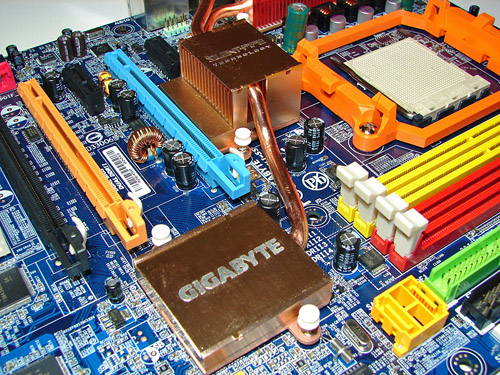
The layout as a whole is near perfect, with every connection in an easy to reach location. The ATX power connectors, both 24-pin and 8-pin, are located on the board edges in places that can be reached without interfering with system airflow. As with the Foxconn motherboard, the 4-pin auxiliary power Molex connector is located at the bottom of the board, but that's about the only potentially difficult to reach location, and this position is commonly used on other motherboards as well so we can't complain too much.

Feelings on the appearance and color scheme of the motherboard are of course up for individual interpretation, but Gigabyte sticks with their traditional blue PCB and brightly colored connectors. Depending on your preference, this may be either attractive or garish. If you're planning on placing the motherboard in a case with a window and UV lighting, you probably like the design. For most other people, it's a minor concern, and as long as everything functions well it doesn't matter too much what color the motherboard is.
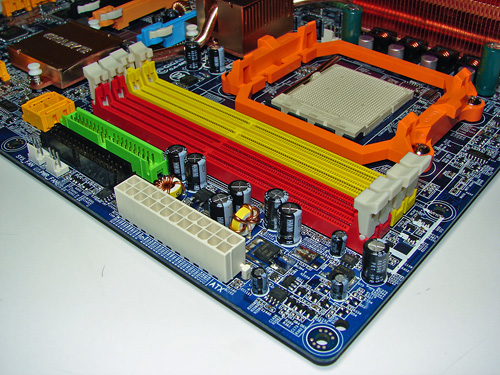
The memory slots are red and yellow, and are properly color-coded for dual channel operation. However, we prefer the configuration of the Foxconn motherboard, which allows you to run with two DIMMs while still having a gap between the memory modules. If you plan to install four DIMMs, it won't matter, and probably more important is that the color coding makes sense. A few manufacturers still seem to think that the slots of each memory channel should be the same color, but the majority of users will assume that you should install two DIMMs into the same colored slots. That seems more logical to us, and we would encourage other manufacturers to follow that color coding style.
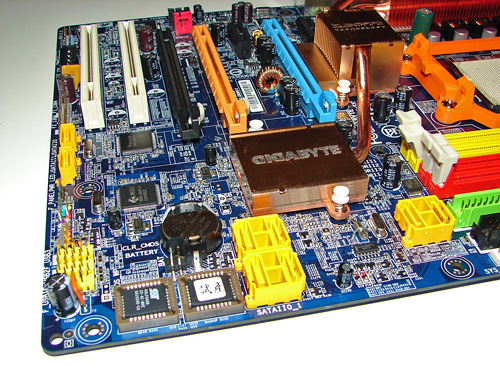
We mentioned before that Gigabyte uses the new clamp and latch SATA connectors, and you can see those in this image of the bottom right corner of the motherboard. Somewhat interesting to note is that this is the first motherboard with clamp and latch connections I've used that actually includes the appropriate clamp and latch cables. Why include the new style connector if you don't include the appropriate cables, right? The bottom two SATA ports are powered by a J-Micro chip. Also included is an eSATA bracket, along with external power, which can be convenient if you ever want to run a hard drive outside of your case. While two eSATA ports are on the bracket, the included external power cable we received only supports one hard drive. Since we are testing a prerelease motherboard, the complete accessory package was not included, so hopefully a power cable for two hard drives will ship with the retail motherboards.
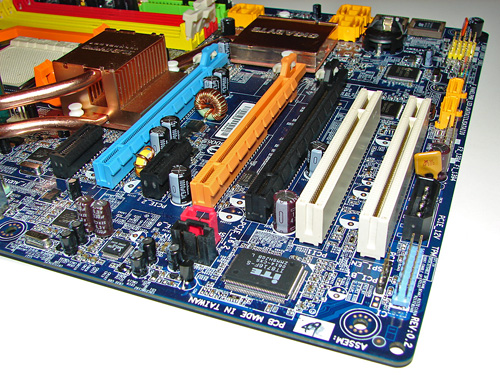
You can also see the Texas Instruments FireWire controller directly below the Southbridge, used to support up to three FireWire ports - one 4-pin connector on the rear bracket, as well as headers for two additional ports. Considering that Gigabyte was the first company to offer 1394b FireWire support on their motherboards, it's somewhat interesting to see that they are using what is generally considered an inferior FireWire chip these days. The FireWire headers are to the left of the bottom SATA ports. Just right of the same SATA ports, you can see the front panel connector block, and to the right of that are the three internal USB headers.

Checking out the rear panel, Gigabyte has chosen to go with a more traditional configuration. You get two LAN ports, four USB ports, six audio jacks, one serial port, one parallel port, the previously mentioned mini FireWire 1394a port, S/PDIF out, and the standard PS/2 keyboard and mouse connectors. All the space on the back panel is put to good use, and while opinions differ as to whether or not parallel and serial ports should still be included, it's at least good to have variety of options in this area among the manufacturers. If you still have an old parallel-port printer that you don't want to upgrade, or any other peripheral that uses one of these ports, then you probably really want the ports. Others might have preferred more USB ports on the rear panel. However, an expansion bracket is included that supports four more USB ports. This uses two of the three USB headers on the motherboard, so you still have one header remaining for any front-panel USB ports.
So what's missing from the Gigabyte board? You don't get onboard reset and power switches (or a small speaker), and some people might have preferred 1394b FireWire. Really, though, there's very little that's wrong with the design of this motherboard. We could nitpick a few areas, but in order to add any more features we would have to give up other features. Do you want the third PCI slot, or should we keep the extra X16 PCI-E slot? We would say Gigabyte made the right choice there, and the only real question that remains is: how does the board perform?
Gigabyte is a name that almost everyone has heard of when it comes to motherboards. They are a tier 1 manufacturer, and they are often one of the first to market with products for a new platform. Gigabyte has also been one of the pioneers in the extreme enthusiast market, with motherboards offering dual BIOS chips in order to recover from failed flash attempts, improved voltage regulation, and innovative cooling solutions. They sent us a prerelease sample of their latest nForce 590 SLI motherboard for testing, which is currently positioned as their top AM2 offering.
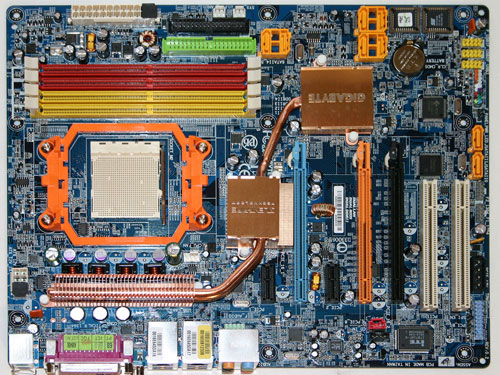 |
| Click to enlarge |
One of the first things that you immediately notice on this motherboard is the impressive cooling solution. Heatsinks connected by heatpipes are used to cool the Northbridge, Southbridge, and some of the voltage regulation chips. What's particularly impressive is the fact that all of the cooling is done without any fans, making for what should be a completely silent motherboard in the right configuration.

The layout as a whole is near perfect, with every connection in an easy to reach location. The ATX power connectors, both 24-pin and 8-pin, are located on the board edges in places that can be reached without interfering with system airflow. As with the Foxconn motherboard, the 4-pin auxiliary power Molex connector is located at the bottom of the board, but that's about the only potentially difficult to reach location, and this position is commonly used on other motherboards as well so we can't complain too much.

Feelings on the appearance and color scheme of the motherboard are of course up for individual interpretation, but Gigabyte sticks with their traditional blue PCB and brightly colored connectors. Depending on your preference, this may be either attractive or garish. If you're planning on placing the motherboard in a case with a window and UV lighting, you probably like the design. For most other people, it's a minor concern, and as long as everything functions well it doesn't matter too much what color the motherboard is.

The memory slots are red and yellow, and are properly color-coded for dual channel operation. However, we prefer the configuration of the Foxconn motherboard, which allows you to run with two DIMMs while still having a gap between the memory modules. If you plan to install four DIMMs, it won't matter, and probably more important is that the color coding makes sense. A few manufacturers still seem to think that the slots of each memory channel should be the same color, but the majority of users will assume that you should install two DIMMs into the same colored slots. That seems more logical to us, and we would encourage other manufacturers to follow that color coding style.

We mentioned before that Gigabyte uses the new clamp and latch SATA connectors, and you can see those in this image of the bottom right corner of the motherboard. Somewhat interesting to note is that this is the first motherboard with clamp and latch connections I've used that actually includes the appropriate clamp and latch cables. Why include the new style connector if you don't include the appropriate cables, right? The bottom two SATA ports are powered by a J-Micro chip. Also included is an eSATA bracket, along with external power, which can be convenient if you ever want to run a hard drive outside of your case. While two eSATA ports are on the bracket, the included external power cable we received only supports one hard drive. Since we are testing a prerelease motherboard, the complete accessory package was not included, so hopefully a power cable for two hard drives will ship with the retail motherboards.

You can also see the Texas Instruments FireWire controller directly below the Southbridge, used to support up to three FireWire ports - one 4-pin connector on the rear bracket, as well as headers for two additional ports. Considering that Gigabyte was the first company to offer 1394b FireWire support on their motherboards, it's somewhat interesting to see that they are using what is generally considered an inferior FireWire chip these days. The FireWire headers are to the left of the bottom SATA ports. Just right of the same SATA ports, you can see the front panel connector block, and to the right of that are the three internal USB headers.

Checking out the rear panel, Gigabyte has chosen to go with a more traditional configuration. You get two LAN ports, four USB ports, six audio jacks, one serial port, one parallel port, the previously mentioned mini FireWire 1394a port, S/PDIF out, and the standard PS/2 keyboard and mouse connectors. All the space on the back panel is put to good use, and while opinions differ as to whether or not parallel and serial ports should still be included, it's at least good to have variety of options in this area among the manufacturers. If you still have an old parallel-port printer that you don't want to upgrade, or any other peripheral that uses one of these ports, then you probably really want the ports. Others might have preferred more USB ports on the rear panel. However, an expansion bracket is included that supports four more USB ports. This uses two of the three USB headers on the motherboard, so you still have one header remaining for any front-panel USB ports.
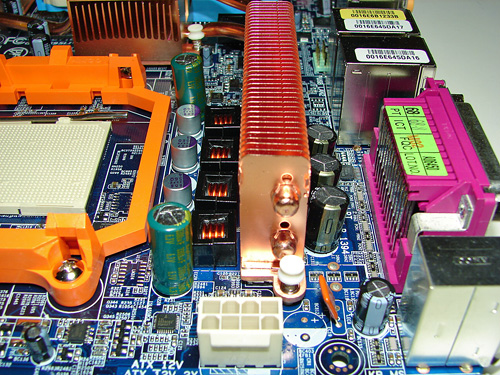 |
| Click to enlarge |
So what's missing from the Gigabyte board? You don't get onboard reset and power switches (or a small speaker), and some people might have preferred 1394b FireWire. Really, though, there's very little that's wrong with the design of this motherboard. We could nitpick a few areas, but in order to add any more features we would have to give up other features. Do you want the third PCI slot, or should we keep the extra X16 PCI-E slot? We would say Gigabyte made the right choice there, and the only real question that remains is: how does the board perform?










36 Comments
View All Comments
Kougar - Friday, June 23, 2006 - link
Just wanted to say thanks for another good review!Really appreciated all the charts and info on the sound, as I've been eyeing the $25 Audigy2 SE (SB570) card that's now out as an upgrade to my old AC97, since it appears to be better than the older Audigy2 ZS (SB360) in some areas... Primary motivation was to offload work from the CPU. Hmm
Operandi - Thursday, June 22, 2006 - link
I think we've gotten to the point now where performing benchmarks on these boards has gotten to the point to where it should be of little concern. I/O performance is slightly more useful but again generally the same within the same chipset family.I not saying the benchmarks are not important, they are. But from a real world stand point it’s so close you’d never now the difference if somebody didn’t illustrate it for you in a pretty graph.
I would like to see more attention paid to board features, by that I mean features aside from overclocking options. Some of us actually have other priorities other then all out performance. For awhile there you guys were looking at fan control for example. What happened to that?, that’s something I found useful, loud fan’s are no fun.
It would also be nice to know about the bundle of the board, what it includes and what it doesn’t, w/ pics.
Providing some information some information on the caps used on the board would also be appreciated.
JarredWalton - Thursday, June 22, 2006 - link
I did try to focus more on features as opposed to benchmarks. The benchmarks are mostly used to show that none of the boards have severe performance problems. Overall, I think the Gigabyte board has more features, with the exception of FireWire 1394b support. I would also say that right now the Foxconn motherboard has the better BIOS implementation.In terms of fan control, both motherboards reviewed here do have "smart fan speed" options in the BIOS. Given that there are no fans on the Gigabyte motherboard, noise is something that will be created by the CPU fan, GPU fan(s), and case fans rather than the motherboard. If you are worried about system noise levels, the choice of cooling and case is going to be almost certainly be more important than the motherboard.
Capacitors? I know the Foxconn board uses some Rubycon capacitors; you can see the label on the close-up shot. My understanding is that these are good capacitors, but honestly I don't know. The Gigabyte board uses Rubycon capacitors as well, though it's a bit more difficult to see the name in the enlarged image of this area.
As far as accessories goes, we only received a preproduction motherboard from Gigabyte, with a few accessories. We are waiting for the complete retail board to show up, and I will provide an image here once that arrives. I did take a picture of the Foxconn accessories, though I didn't include it in the actual article because it just didn't seem that important. For those that are interested, here it is:
http://images.anandtech.com/reviews/motherboards/r...">Foxconn Accessories
Operandi - Friday, June 23, 2006 - link
Since a system is only as quiet as its loudest fan, fan control is a very important tool. In my opinion just as important as heatsink, fan, and case choice.The whole idea behind BIOS (or software) level fan control is that it offers dynamic control over all of those loud CPU, system, as well northbridge fans; it has very little to do with the noise output of the motherboard itself. Basically it’s much better alternative to manual fan controllers, you get the cooling performance when you need it (gaming, encoding, ect.) and much quieter system then would otherwise be possible at idle. Having built several high-end yet dead silent systems it’s pretty much a requirement for me at this point.
More to the point fan control is a feature and since we both agree that features are more important then the benchmarks why exclude it?
JarredWalton - Saturday, June 24, 2006 - link
I can't remember the last time I encountered a BIOS without fan speed controls. It wasn't excluded because it's not important, but more because it's so common now that I take it for granted. Sorry. Will try to make sure I mention this next time. :)Operandi - Tuesday, June 27, 2006 - link
Excellent ;)BIOS fan control is kind of like overclocking options. Most boards at least support it but some are obviously better then others.
Example, some boards may only control the CPU fan, or offer very little in the way of flexibility. Others are much better; and can control multiple fans and offer a wide range of temperatures and speed settings.
Per Hansson - Friday, June 23, 2006 - link
The caps used on the Foxconn are Rubycon MCZ which is the best cap out there period, however I also saw a small Ost cap in the high-res picture but generally caps below 1000µF rarley fail (and Ost is among the better of the crap brands...)And to answer the comment about Rubycon and Taiwan; They make most of their caps in Japan, check their site out, Rubycon is one of the largest and definantley best regarded capacitor manufacturer. AFAIK they only have a branch office in Taiwan
I think mainboard manufacturers that only use good capacitor brands should deserve a definitive extra point for this, because unlike the other comment the "capacitor issue" is not at all over, it is only getting worse with increased demands on newer processors with more cores and higher power usage... Currently there are more Pentium 4 boards with Badcaps than there are AMD being reported on the site Badcaps.net but that is most likley because the P4 boards simply demand more from the capacitors so they fail sooner. If crap caps are used on AMD boards it is however just a matter of time untill they will also fail.
There is a reason Abit took the plunge after the lawsuit against them and went with 100% Rubycon only capacitors...
Just FYI on the Foxconn I spotted these cap brands:
Rubycon MCZ for VRM input (12v side)
Fujitsu fpcap (V-Core side of VRM, the yellow caps...)
United Chemi Con (unknown model but probably KZG, spread around the board...)
On other samples I have also seen Teapo and Lelon, the Lelon are utter crap, in the same level as GSC, on this sample there where not Lelon though, easy to spot with their light green color...
So the Foxconn is IMO a mixed bag, on one side they really spent some money for good caps around the VRM and also the nice Chemicon caps spread around the board, but cheaped out on the TEAPO, Ost and other misc stuff... The bad caps might be ok though since they are below 1000µF but might still cause the strange mysterious issues like power down/up failures (cold boot issues) etc...
The Gigabyte uses 2x 3300µF Sanyo (probably WG) caps for CPU VCORE, along with 4x Sanyo solid Polymers, a very odd combination that I have not seen used elsewhere... Then it uses only 3x input caps for the 4-phase VRM however they look pretty large so they might hold more capacitance than more regular layouts with one cap for each phase... (they appear to be Nichicon but I'm not certain)
Next there are a few United Chemicon caps spread out, along with Nichicon HM
Had this been an older board the Nichicon HM would have been given a warning but that issue seems to have been fixed by now (there was a bad batch that affected even Intel mainboards...) Still if they are old capacitors from stock there could be problems, but I think Gigabyte known better than this...
So to recap (haha) I would say that the Gigabyte gets my 2x thumps up for Capacitor choices and the Foxconn only gets one due to cheaping out on the small capacitance caps, of course with the note that I own neither board and am only going by the not so high resolution pictures of this review...
But all in all a heads up to Anandtech for providing high-res pictures of some of the capacitors, good job
sprockkets - Friday, June 23, 2006 - link
Just to add, yes, Lelon caps exploded on my MSI boards, and on my Chaintech 7SID0 board, a great SIS735 board, the OST caps are exploding on them. Oddly enough though, the OST caps on my old Shuttle XPC SS40G are not.On the Foxconn board, their uATX nforce 4 board, it also uses rubycon for the power supply side but cheap ones for the rest.
JarredWalton - Friday, June 23, 2006 - link
Damn... I humbly bow to your *far* superior capacitor knowledge. I did get hit by the badcap bug with an older Abit BE6-II board, and had a few systems I built fail for similar reasons. Thankfully, no recent problems for me. I've tried to get better pictures of the capacitors, but I have yet to figure out how to get clear pics without depth-of-field coming into play. Gary managed to get much better results, so most of the images are from him.BIOS failures are my problem lately... I've had four boards die during BIOS updates the past 6 months, and two last week. (Possibly an early AM2 issue).
Per Hansson - Friday, June 23, 2006 - link
Well, thank you but it's become more of a necessity to learn (by replacing dead capacitors on mobos because the mobo manufacturers cheaped out in the first place...)About the pics, I assume the Sony DSC-H1 camera is Garys? Quite impressive shots, I've been looking for a replacement for my Konica KD-400Z but never found anything with a much better macro function than my Konica for the use I have... And don't wanna go SLR...